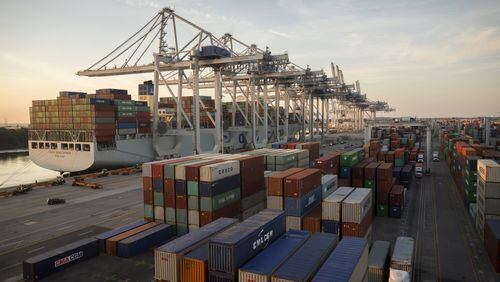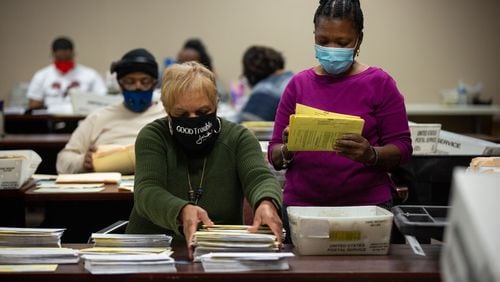The project to deepen Savannah’s harbor got a boost this week from President Donald Trump’s budget proposal, just not as much of a lift as some backers of Georgia’s ports wanted to see.
Boosters had hoped for about $100 million in the fiscal 2018 budget to dredge the Savannah River, but the White House’s spending plan of $50 million, while a high-water mark for the federal government, falls well short.
And the U.S. Army Corps of Engineers dashed hopes by Georgia leaders late Wednesday when it announced no discretionary construction funds from fiscal 2017 would be added to this year’s appropriation. That decision could put the project at risk of further delays.
Still, in a budget blueprint that calls for deep cuts for entitlements and other domestic programs, Georgia leaders on Wednesday touted the new money as a win after years of uncertainty about federal funding for a project that has risen in price to nearly $1 billion.
"In a budget crafted with many spending reductions, it is extremely reassuring to see that this administration realizes how important this project is not only to our area, but to the entire nation," said U.S. Rep. Buddy Carter, R-Pooler, whose 1 st Congressional District includes the Savannah port.
“Now, I will work diligently with my colleagues to continue this momentum and fight for (the project) as budget discussions continue,” he added.
Last month, the feds announced that the project’s costs would jump 38 percent to $973 million, putting the squeeze on state leaders and Congress to find money to complete it.
Gov. Nathan Deal said earlier this month that he was committed to finding state resources to finish the project while also holding the federal government to its promise to pay for three-quarters of the total cost.
On Wednesday, Deal’s office said in a statement that it was “grateful” for the $50 million from Trump’s budget, calling it a “sign of good faith from the federal government.”
“Unfortunately, the Army Corps of Engineers chose not to prioritize this project in its discretionary funds,” the statement said. “It is our hope that the Corps will decide to devote future funding to (the Savannah port project) so that it will continue on its current timeline.
“While the governor is certainly thankful for President Trump’s and the Congress’ contributions to this effort, we look forward to the federal government following Georgia’s lead by fully funding its portion of this vital project,” Deal’s office said.
The state’s port system is a vital part of metro Atlanta’s economy and its status as a national logistics hub. Georgia ports account for some $40 billion in estimated economic impact across the state, and they directly or indirectly touch about 400,000 jobs.
In its request for the 2018 fiscal year that begins Oct. 1, the Trump administration told Congress it would like to set aside some $50 million for ongoing dredging work to deepen the harbor from 42 feet to 47 feet.
That's a 17 percent increase above the amount that lawmakers and the Obama administration agreed to give the project last year , but it's half of what boosters say is necessary each year over the next four years to keep the project on schedule.
Backers of the Savannah port, however, framed the request as a good omen. Many have long complained that the federal government has taken too long to fork over its now $640 million share of the project, after the state ponied up $266 million in seed money several years ago.
Congress’ final product
As is the case with all presidential budget requests, Congress is expected to substantially alter the Trump proposal. But with individual projects such as the Savannah port, lawmakers tend not to tinker with the White House’s proposal so they don’t run aground of the 6-year-old earmark ban.
There had been some optimism among Georgia lawmakers on Capitol Hill that the project would be in line this year for extra money from the federal government thanks to a broader account in the U.S. Army Corps of Engineers’ budget that’s devoted to funding ongoing construction projects.
There's also hope that more money could be in the pipeline should Congress and the administration move to accelerate an infrastructure package .
Combined with the $42.7 million already allocated for fiscal 2017, Georgia Ports Authority Executive Director Griff Lynch said the dredging project will not lose any time.
“We’re heading in the right direction,” Lynch said. “The money is there, and the corps is telling us we are their top priority project.”
The venture has been in the works for years and enjoys bipartisan support in Georgia as a core economic development project that will bring jobs and money to the region in conjunction with the newly expanded Panama Canal.
Trump’s proposed funding increase for the Savannah River is notable given that his administration proposed slimming the corps’ overall budget by more than 16 percent, a move that raised the ire of Democrats.
“Despite President Trump’s repeated promises to rebuild roads, bridges, airports and other infrastructure, the budget proposal the administration released today is actually a net cut to infrastructure spending,” the office of Senate Democratic leader Chuck Schumer said in a statement.
Taking bigger ships
The Savannah port is the nation’s No. 4 container port by volume, and the Ports Authority said this week that the system had its best-ever month of April in terms of tonnage.
That came the same month after the corps announced the cost spike for the expansion work, and that dredging would take two years longer to complete than initially expected. But on the bright side, the nation’s return on taxpayer investment is expected to be greater even after the price spike because of savings in freight transportation costs.
The channel deepening project is one of the largest infrastructure projects in state history. The project would deepen the river channel to 47 feet over a span of about 40 miles from the port to the Atlantic Ocean.
The project is seen as vital to help Savannah be ready to accept ever-larger freighters transiting an expanded Panama Canal.
“We’re not only shovel-ready, we are dredge-ready,” Deal said May 12. “We have dredges in operation. We just need to finish it. I think we’re going to get great cooperation from the Corps of Engineers. They’ve been great partners, by the way, to getting to this point.”
Earlier this month, Savannah welcomed the largest container ship to ever visit an East Coast port, a harbinger of bigger ships to come . For now, megaships visiting Savannah can only ply the channel during high tides when less than fully loaded.
Other rival ports on the East Coast have also spent big on upgrading their infrastructure and expanding their channels in expectation of larger ships transiting the Panama Canal.
At one time, 12 megaships were expected to cross the new Panama locks per day, a forecast that was later cut to two to three ships daily. Canal officials say they’re now averaging about six of the largest vessels per day.
Taylor Howerton, a senior vice president and ports and logistics industry specialist with SunTrust Banks in Atlanta, said shipping costs on the East Coast are more competitive with West Coast ports with both the Panama Canal’s expansion and larger ships flowing through the Suez Canal in Egypt.
As a result, goods that traditionally would travel from Asia to Los Angeles, for instance, and move east by rail, now head by ship to American ports on the Atlantic.
“Shippers are going to naturally choose their routes based on economics,” he said.
The Port of Savannah
The Savannah port is the fourth-busiest container port in the U.S. and the second-busiest (after New York/New Jersey) on the East Coast.
Top exports: Wood pulp, paper and paperboard, poultry (fresh and frozen)
Top imports: Furniture, auto parts, general cargo
Economic impact: An estimated impact of nearly $40 billion on Georgia's economy, with about 400,000 jobs in the state tied directly or indirectly to the port
Sources: Georgia Ports Authority, University of Georgia
The Savannah Harbor Expansion Project
Cost: Now estimated at $973 million, up 38 percent from earlier projections
State share: Georgia has already raised $266 million. That could rise by about $67 million.
What will it do? Deepen the river from 42 to 47 feet, while also mitigating environmental issues
Other stats: The project is about 41 miles long, from the Garden City Terminal into the Atlantic Ocean. About 24 million cubic yards of river mud will be dredged, enough to fill seven Georgia Domes.
Estimated completion: January 2022
Return on investment: It is now believed that each dollar spent will return $7.30, or $282 million annually, mainly from savings in transportation costs.
Source: U.S. Army Corps of Engineers, AJC archives
GOVERNMENT AND POLITICAL NEWS
If it happens in Washington or under the Gold Dome, The Atlanta Journal-Constitution has somebody there to tell you what it means for all Georgians. Follow our coverage at http://www.myAJC.com/politics .
You can also join the conversation on Twitter at http://Twitter.com/GAPoliticsNews or Facebook at http://facebook.com/gapoliticsnewsnow/









